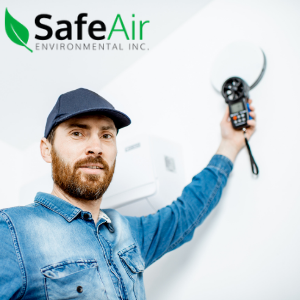How to Improve Indoor Air Quality
Posted in Air Quality, on June 07, 2022
 With summer comes a higher proportion of days with a poor air quality index. While outdoor pollution tends to grab the biggest headlines, it's indoor air quality that most of us should be concerned about. Indoor air quality testing with SafeAir is the easiest and most effective way to test your indoor air quality for hidden pollutants and allergens. Air quality testing is a science-based method for taking a holistic look at the factors that affect your indoor environment, from humidity to moisture to VOCs, asbestos, radon gas, and more.
With summer comes a higher proportion of days with a poor air quality index. While outdoor pollution tends to grab the biggest headlines, it's indoor air quality that most of us should be concerned about. Indoor air quality testing with SafeAir is the easiest and most effective way to test your indoor air quality for hidden pollutants and allergens. Air quality testing is a science-based method for taking a holistic look at the factors that affect your indoor environment, from humidity to moisture to VOCs, asbestos, radon gas, and more.
What Affects Indoor Air Quality?
Indoor air quality can be affected by many different pollutants. It can be related to your home's size, age, or physical location, or the objects and substances you bring into it. Some of the most common causes of poor indoor air quality that the SafeAir team encounters include:
- Recent construction or renovation
- Mold growth
- Scented cleaning supplies/products
- Pests
- Radon gas
- Age (insulation with asbestos, lead paint)
- Moisture and humidity
Physical or Health Signs of Poor Air Quality
One of the tricky things about poor air quality is that there isn’t always an obvious sign or symptom that there’s a problem. In fact, the most common signs are experienced in our bodies — and are misdiagnosed as the cold, flu, or seasonal allergies!
Because the air we breathe directly relates to our body’s health and wellness, the first signs of poor air quality are usually noticed in our bodies. Clients commonly report feeling:
- Fatigued
- Headaches
- Nausea
- Itchy or watery eyes
Sneezing or nasal congestion
If you feel as though you have a lingering cold or if your symptoms miraculously clear up when you leave a certain room or head to work in the morning, there may be more at play than a virus or bacteria.
How to Assess Your Indoor Air Quality
Indoor air quality is difficult to assess using your physical senses — which is why SafeAir always recommends professional air quality testing. We’ll bring our sensitive, professional-grade tools and lab-tested methodologies to take a complete look at your home’s ecosystem. Indoor air quality isn’t just about what’s indoor either — factors outside of your home, such as being situated in a floodplain or near low-hanging trees, can adversely affect the home's conditions and lead to air quality problems.
How to Improve Indoor Air Quality
At SafeAir, our approach is to treat each home as a unique environment that may (or may not) need certain interventions to make it a safer and healthier place. But there are a few things you can do without our help to improve your indoor air environment! Here are our top 3.
1. Improve Ventilation.
Good airflow is the best way to improve your indoor air environment. There’s a reason fresh air is good for us! Increasing and improving your indoor ventilation is as easy as opening the windows on a breezy day or running a fan to promote air movement.
2. Ditch scented products.
Scent-free workplaces are becoming more common as adverse reactions to perfumes and other scented products rise. Scents are created by particles called Volatile Organic Compounds, or VOCs. The smell of a freshly zested lemon is one — but so is the lemony scent of floor cleaner. Many common fragrances and VOCs created from cleaning products have been shown to cause respiratory problems and negatively affect the skin, eyes, and nose. Choose scent-free or low-VOC products to change your air quality instantly.
3. Get a Dehumidifier or air purifier.
There are plenty of dehumidifiers and air purifiers on the market today. Ranging in price, they can be an excellent way to combat areas with high humidity and help reduce airborne allergens. The SafeAir team uses dehumidifiers in basements to help prevent mold growth and puts their air purifier in the bedroom for a good night’s rest.
How Can SafeAir Help?
If you have questions or concerns about your home, we’d love to help you with indoor air quality testing. This service can help any home and will reduce some of the common triggers for allergies, asthma, and more. To learn more about SafeAir’s air quality testing, read through our blog archives and reach out via phone or email to book your assessment today.

